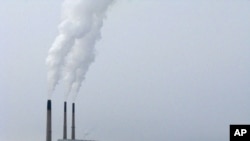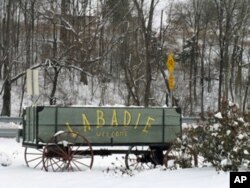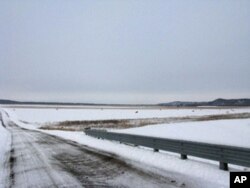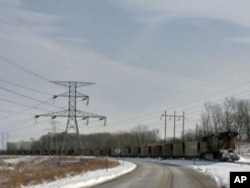Coal consumption is increasing in many parts of the world, driven by skyrocketing energy demands in rapidly developing countries like China. But with coal comes pollution: from climate-changing carbon dioxide to coal ash, the powdery toxic waste left over from burning coal to produce electricity.
In the United States, coal-fired power plants produce more than 130 million tons of coal waste each year. The debate over how to dispose of it is playing out in the small town of Labadie, Missouri where the controversy is pitting local residents against the Midwestern utility company, Ameren.
It all started with the Labadie ladies book club back in the summer of 2009.
"Everybody was just gathering, and somebody kind of off-handedly said, 'Oh, did you all hear that so-and-so just sold his bottom ground,'" says long-time area resident Kay Genovese. "And nobody had heard about that, and she said, 'Yeah, I heard he sold it to Ameren.'"
Bottom ground is land in the floodplain of the Missouri River. Genovese says at the book club the next month, they found out another farmer had sold his land.
"And we were like, 'Oh, to Ameren again?' Three months in a row, we kept hearing about these different farmers selling their ground to Ameren."
The book club ladies started asking questions. They found out that the utility company Ameren was planning to build a 160 hectare [400 acre] coal ash landfill in the floodplain, next door to its massive power plant in Labadie.
Shift supervisor Jim Dean says, with its four huge turbines, Labadie can generate enough power to supply electricity to almost half a million homes. To do it, the place burns coal by the train load.
"Each train has about 130 cars in it. Each car holds 100 tons of coal. And we’ll burn one car, 100 tons of coal, in about four minutes with all four units at full load," Dean says.
At two coal trains a day, that works out to about 10 million tons of coal a year. Approximately seven percent of that - over half a million tons - is left over as coal ash.
Ameren recycles more than half of it. The rest gets mixed with water, and sluiced out to two open ponds next to the plant. The coal ash settles out to the bottom, and the remaining water gets discharged, untreated, into the Missouri River.
Ameren’s Vice President of Environmental Services, Mike Menne, says those ponds are running out of room. At a 160 hectares, the new landfill would be big enough to replace them both, and take ash from Ameren’s Meramec and Rush Island plants, too.
Menne says the new landfill would have protection systems the current ponds lack. It would be double-lined to protect groundwater, and have a berm around it - about as high as a two-story building - to keep floodwaters out.
"And then it has what’s referred to as a leachate collection system which is a water collection system," says Menne. "Any water that would percolate through the material is collected and sent back to the plant to be used for process water."
Even with all the new safety precautions, many area residents are worried about all that ash, and what’s in it: toxic elements like arsenic, chromium, and lead, which can cause cancer, developmental problems, and other serious health issues.
They’re afraid those hazardous substances could wind up in groundwater or the Missouri River, and contaminate area drinking water supplies. They’re also concerned about property values, and increased truck traffic.
The Labadie book club ladies, who first found out about Ameren’s landfill plans, got organized, and gave themselves a name - the Labadie Environmental Organization - which now has close to 400 members.
One of them is Labadie resident Petra Haynes. She hopes Ameren will, as she puts it, "do the right thing" and not build a landfill in the floodplain.
"We really firmly believe that there has to be a better, safer location," she says. "We would like Ameren to really consider the safety and well-being of their customers, rather than the bottom line."
She and other area residents have been voicing their concerns at public hearings with the local county board of commissioners. The board is trying to decide whether to change county zoning regulations to allow utility waste landfills like Ameren’s.
Presiding Commissioner John Griesheimer says he understands why people don’t want a landfill in the floodplain.
"But the bottom line is we have to put it somewhere. To be opposed to it, and have an alternative is one thing, but to be just opposed to it without giving us another option here, that’s another matter, and that’s what’s hard for everybody to do."
Griesheimer says a final decision on the county’s landfill regulations is still months away.











